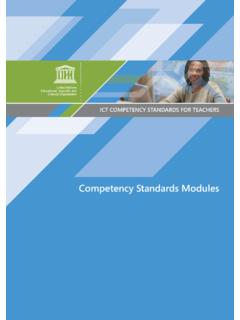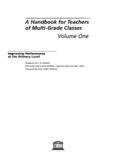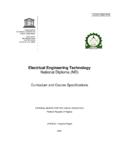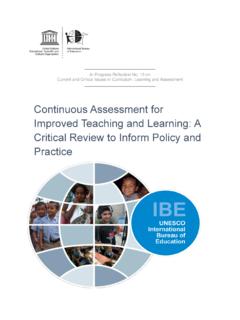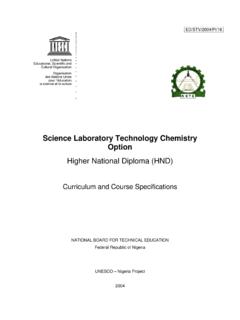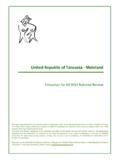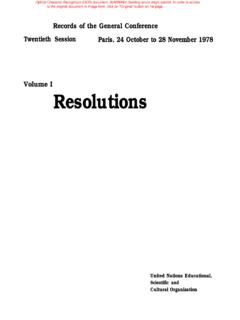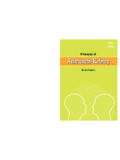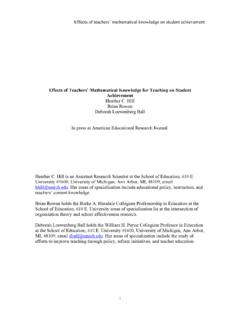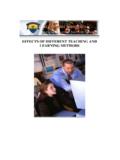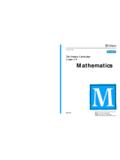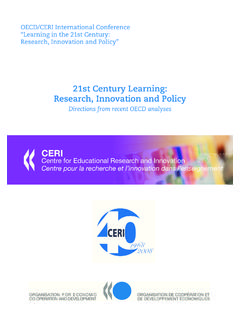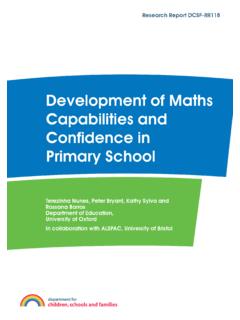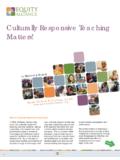Transcription of Role of teachers in motivating students' interest in ...
1 BOver the years, students' performance on public examinations in Science,Technology and Mathematics (STM) has been poor ( Ivowi et al, 1992;Adeyegbe, 1993; Adeniji,1998). Many sources of poor performance, spanningboth students' and teachers ' factors, have been provided in the literature. Sincestudents' performance dominate the yardstick upon which data could be collected toascertain their interests in STM, it is reasonable to focus on how to motivate suchinterest in students. Again, STM abounds essentially in the classroom, workshops andlaboratories where the presence of teacher is highly crucial and beneficial. In doingSTM, the role of the teacher in motivating students' interest in those subjects cannot bein doubt. Although these students', as learners, have complete responsibility for whatthey learn, they are to be guided by their teachers in their quest for knowledge.
2 Withproper interaction between teacher and students, interest in STM can be developed is crucial for national development. Since youth are expected to beinvolved in the development of the nation, they need to be well grounded in STM inorder to cope with future activities. To succeed in this venture, their interest in STMneeds to be sustained once it is generated. To sustain interest , it is necessary to ensurethat the population of students is adequately catered for by taking measures towardsgender fairness and balance. But there exists already sufficient biases against the girlsin STM: therefore, extra care needs to be taken to ensure that girls' engagement, per-formance and interest in STM are enhanced. More importantly, the wide ability rangesbetween boys, and girls, and among boys or girls, need to be recognised and the concepts of interest and motivation, it is necessary to ascertain theireffects, and manifestation, while attempting to ensure their generation and and the specific roles of teachers in instructional strategies together with thepossible assistance to teachers to enable them to perform their obligation to studentswill be examined in this ordinary meaning of the term, interest is a state of concern or curiosity.
3 It is tocause to become involved in something. To show interest in a thing is to be activelyinvolved with that thing; to show concern for or have curiosity in that thing. To beinterested in science and mathematics involves showing sufficient concern for andcuriosity in the subject by being activity involved in all activities related to thesubject. This will entail doing science and mathematics in all their - Newsletter . March 2001, , . Page 1 NewsletterMarch 2001, , of teachers in MotivatingStudents' interest in Science andMathematicsBy Professor Uduogie IvowiIntroductionnternational Institute forCapacity Building in AfricaIICAI nterest in science and mathematics can be manifested inmany ways, some of which include:.reading texts in the subject area;.developing related attitudes and attributes such as curiosity, logicality and evaluation.
4 Manipulation of devices such as a tools and equipment, and of data;.display of data in various forms; of related concepts, principles and ideas in major effect of interest in any endeavor is significant displayof efforts in the area. Such efforts could be seen in terms ofrepetition of activities without a feeling of boredom, improvedperformance in related undertakings and originality or innovation inthe area ofconcern. A feeling of fulfillment becomes inevitableparticularly as novel applications result with the display of the use ofproblem-solving is not easy to generate interest if the potential is not can be more easily aroused but unless there is a concrete fac-tor to sustain such interest , it may soon be lost. An intrinsic or extrin-sic motivating factor becomes necessary in the generation and suste-nance of interest in any subject. For science and mathematics, inter-est can be generated by many factors such as.
5 Novel demonstration and applications:.relevant illustration;.simple explanations of common phenomena and events;.successful demonstration of results from manipulation of devices; of creativity;There is no doubt that these are not easy to achieve; but anelement of perseverance is needed to succeed. This is where theteacher, with experience and determination to excel, can play a majorrole in stimulating interest in motivate is to instigate or incite. A student's desire forknowledge, need for achievement, ego-involvement, interest in aparticular subject matter are all explained by motivational attitudinalbehaviors (Akibye, 1996). As he stated further, such behaviorscritically influence a student's attentiveness, degree of commitmentand concentration on learning. Motivation is an important factor inlearning generally and school learning in particular.
6 It may beintrinsic, as in the case of personal satisfaction and self-fulfillment;or extrinsic, as in the case of reward of an enchanting position oraward of material benefit or recognition in , according to Akiboye (1996) affects learning in threeways:.It triggers off behavior sequences in the learner when it isPage 2 . IICBA - Newsletter . March 2001, , of teachers inMotivating Students' Interestin Science and are the Problem,not Girls! Elements of Scienceand Technology Education forall in Africa: Views Education Reformin African Renaissance inScience Education: a UK-South Africa Education in theSchool Curriculum: itsRelation with IN BRIEFThe IICBA Newsletter is published quarterly inEnglish and French. Articlesmay be reproduced with attri-bution. We welcome editorial comments or inquiries aboutIICBA Please address all correspondence to: The EditorIICBA 2305 Addis Ababa, Ethiopia AfricaTele: (251) -1-557587 Fax: (251) -1-557585 Email: site this Issuepresent; and since learning is said to be reaching, the learner so activated attainslearning readiness.
7 It is said to lower the threshold of reinforce ment, so that reinforcement can more easily be contingent on could serve as prompts or stimulus discrimination for from these effects of motivation onlearning, manifestations of motivation can takemany forms, some of which include the following:.Increased attentiveness in class and in learning situations;.Improved degree of commitment by positive response to assignments; degree of concentration in learning which could result in better display of under- standing of content and attainment of motivation could be intrinsic, anencounter with the goodness of a cause like asubject matter and a display of an enablingenvironment could aid the generation andsustenance of motivation. For the extrinsic factor,relevance of the subject matter to one's concept oflife and aspiration plays a major role in beingmotivated andremaining in that state whilelearning is taking teachers interest with students, andteaching/learning materials as well, guide thestudents in their learning encounter, their role inmotivating students' interest is significant, and evenmore demanding when such interest needs to ' RoleGiven the crucial role of teachers in a learn-ing situation, they must affect students' interest inscience and mathematics, like all other subjects.
8 Inparticular, focus can be placed on two areas wherethe teacher plays a major role. These are curriculumprovisions and instructional strategies. As indicatedearlier (Ivowi,1996), these are capable of sustainingstudents' interest in science (including mathemat-ics).For curriculum content, some of the measuresfor sustaining students' insert include:.Provision for wide ability ranges;.Provision for various interest within the three domains of education objectives;.Provision for various subjects in the curriculum;.Provision for various applications of subject ;.Provision for stimulation through readersseries and co-curriculum for this are discussed inIvowi(1996); and since teachers are key factors inthe development and implementation of science andmathematics curricula, their role here relates to themotivation of students' interest in the subject mat-ter.
9 But the provision of curriculum materials is notenough to ensure the sustenance of students' inter-est in science and mathematics; the way the materi-al are taught to students matters a lot, not only forlearning to take place but for learners to makeefforts for learning to occur. Good teaching and use of relevant tech-niques are some roles which the teacher needs toplay to arouse and sustain interest in students. Somefactors which determine good teaching are:.the teaching technique employed;.the feedback mechanisms adopted;.the reward system advocated;.the influencing variable taken cognisance of byteachers; range of pedagogic strategies available tothe of the techniques advised for use dur-ing the period of interaction between the teacherand the students and jokes so that student's' attention is assured;.Discussion aimed at fully involving the students in the process of teaching and learningscience and mathematics.
10 Practicals for the purpose of giving the studentan opportunity to do science, to find out the truth and verify claims in order for meaning to be attached to the science lessons;.Fields trips to see things in their natural environment, appreciate applications and eliminate boredom;.Projects for the purpose of allowing students to do some independent investigation by consulting literature, peers and other persons;.Summary to present in a form which coincides with what has been taught, for ease of reference and - Newsletter . March 2001, , . Page 3 The purpose of learning is for full under-standing to occur; and this happens if a wholeconcept or principle is completely understood interms of structure, application and , teaching and learning take place, andfeedback is needed. This has its various stated by Gipps(1995), there are influencingvariables which teachers must take cognisance of inorder to sustain students' interest in science.
